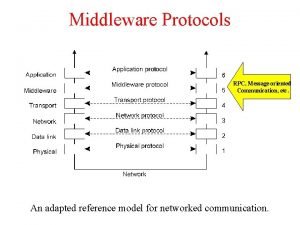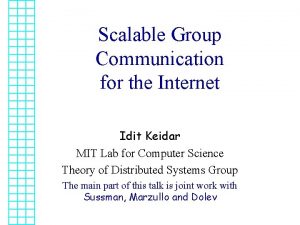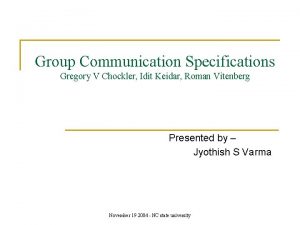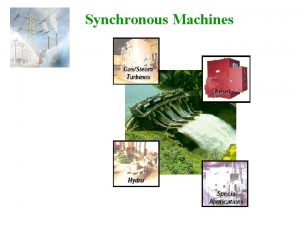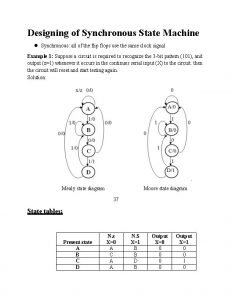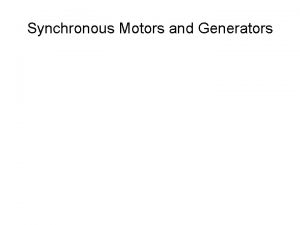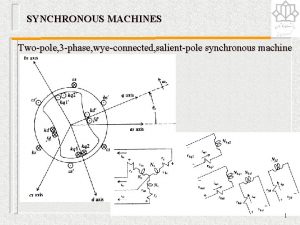Algorithm for Virtually Synchronous Group Communication Idit Keidar


















![Implementation • VS library (C++), linked with application • Use [KSMD, 00] membership service Implementation • VS library (C++), linked with application • Use [KSMD, 00] membership service](https://slidetodoc.com/presentation_image_h2/e26e1f65a4f791d369f116d5131185cf/image-19.jpg)
- Slides: 19

Algorithm for Virtually Synchronous Group Communication Idit Keidar, Roger Khazan MIT Lab for Computer Science Theory of Distributed Systems Group

Talk Outline • • Motivating applications Group Communication Virtual Synchrony Existing solutions Problems with existing solutions Our idea Our contributions Implementation

Motivation: Modern Distributed Applications • Highly available servers – Web – Video-on-Demand • Collaborative computing – Military command control – Shared white-board, shared editor, etc. – Online strategy games • Stock Market

Common, Important Issues in Building Distributed Applications • Reliable communication • Consistency – same picture of game, same shared file • Fault-tolerance, high-availability – failures, recoveries, partitions, merges • Scalability • Performance

Group Communication -Useful “Building Block” • Group Abstraction – processes interact in a group – dynamic: fail/join/partition/merge • Reliable Group Multicast • Group Membership -- generates “views” – tell each process who it is connected to • Systems: Ensemble, Horus, Isis, Newtop, Psync, Sphynx, Relacs, Totem, Transis

Example: Group Communication

Virtual Synchrony • Synchronization of Messages and Views: Procs that go together through same views, deliver same sets of messages. • Powerful abstraction for replication • Semantics: VS [Birman, Joseph 87], EVS, SVS

Example: Virtual Synchrony

Virtual Synchrony: How To? • Before moving into new view: Exchange synch messages (“flush”) to agree which msgs to deliver in old view. • Need to know which synch msgs to use, since there may be several view proposals

Example: Synchronization Msgs

Problematic Scenario

Existing Solutions • Limit Reconfiguration – Do not allow joins during reconfiguration – When someone wants to join: • first, deliver view without joiner; • then, start new reconfiguration. • Use common id to identify synch msgs for same view proposal

Limited Reconfiguration

Problems with Existing Solutions • Limited Reconfiguration – Obsolete views delivered to application – Creates overhead – Limits usefulness of virtual synchrony • Use of common id to identify synch msgs – Pre-agreement or dissemination is required – Costly, especially in WANs

Our Idea • Don’t limit reconfiguration • Issue locally unique id per process for each view proposal • Tag synch msgs with these local ids • View includes vector of latest local ids – View is a triple: e. g. , < 4, {p, q, r}, [8, 9, 3] > • Procs use sync msgs identified by view • Hence, procs use right sync msgs

Our Algorithm Allows Joiners

No Common Sync Ids Required

Contributions • Algorithm for Virtual Synchrony – useful commonly provided semantics – processes can join during reconfiguration; hence, more benefit from Virtual Synchrony – one round, in parallel with view reconfiguration • Architecture – external membership service ([KSMD, 00]) • Formal Treatment – specs, algorithm, safety and liveness proof
![Implementation VS library C linked with application Use KSMD 00 membership service Implementation • VS library (C++), linked with application • Use [KSMD, 00] membership service](https://slidetodoc.com/presentation_image_h2/e26e1f65a4f791d369f116d5131185cf/image-19.jpg)
Implementation • VS library (C++), linked with application • Use [KSMD, 00] membership service implemented in C++, socket interface with members • Reliable FIFO layer (made in Hebrew University), uses IP multicast and recovers lost messages, library --- linked with VS
 Internal and external assessment in strategic management
Internal and external assessment in strategic management Virtually anything is possible
Virtually anything is possible Competition in virtually all industries is
Competition in virtually all industries is Sabre virtually there
Sabre virtually there Rearden personal assistant
Rearden personal assistant Lutgens and tarbuck
Lutgens and tarbuck Transient synchronous communication
Transient synchronous communication Middleware protocols
Middleware protocols Kontinuitetshantering i praktiken
Kontinuitetshantering i praktiken Novell typiska drag
Novell typiska drag Tack för att ni lyssnade bild
Tack för att ni lyssnade bild Returpilarna
Returpilarna Varför kallas perioden 1918-1939 för mellankrigstiden
Varför kallas perioden 1918-1939 för mellankrigstiden En lathund för arbete med kontinuitetshantering
En lathund för arbete med kontinuitetshantering Särskild löneskatt för pensionskostnader
Särskild löneskatt för pensionskostnader Personlig tidbok fylla i
Personlig tidbok fylla i Anatomi organ reproduksi
Anatomi organ reproduksi Densitet vatten
Densitet vatten Datorkunskap för nybörjare
Datorkunskap för nybörjare Tack för att ni lyssnade bild
Tack för att ni lyssnade bild







